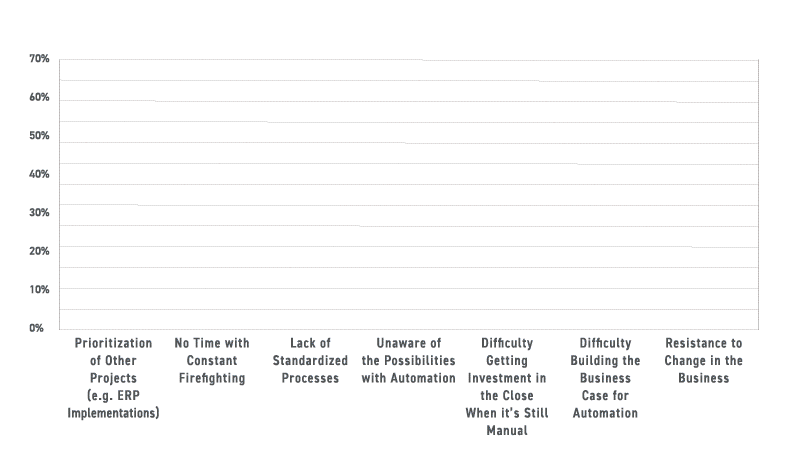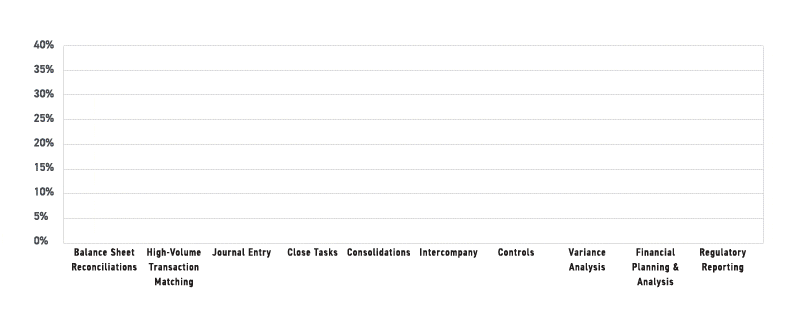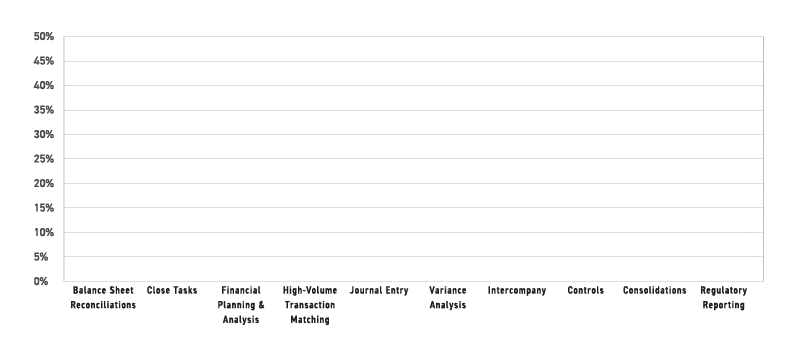Adopting the Solution: Finance Automation
Blog post
Share
Finance automation is the way of the future; however, many organizations are still engaging in a manual financial close. While there are many benefits to automating the financial close process, there is also a significant lack of understanding and adoption of automation solutions. This blog will cover our findings from Trintech’s 2022 Global Financial Close Benchmark Report and discuss the importance of leaning into digital transformation to gain a competitive advantage.
Organizations are Lagging in Adopting Automation Solutions
The benefits of finance automation include increased standardization, time and cost savings, increased visibility, and strengthening of the control framework. While these benefits are known, many organizations have still not taken action to invest even though they know that their lack of finance automation is contributing to an inefficient close process. According to our survey, 74% of respondents reported that they still do not have “established” or “advanced” automation in place today.

The majority classify their level of automation as “basic” or “developing” (seen as laggards — barely utilizing automation and suffering not only from time-consuming financial close processes but a loss of talent because of inefficient and mundane processes that could be solved through automation.). According to a study by Deloitte, over 42% of respondents still use a considerable manual effort for their close process but have short-term plans of implementing finance automation tools to solve their tedious processes.
What Prevents Finance Teams from Automating?
While companies realize that remote/hybrid working is now the norm and end-to-end automation is foundational to the long-term success of a hybrid/remote model — they are still letting other issues deter them from taking action. It is not just enough to realize that finance automation is no longer optional — there must be a plan in place to make it happen.

Many organizations cite that prioritization of other projects like implementing or upgrading ERPs is a factor that has prevented them from automating their financial close process and it is imperative to note that ERPs are good at what they are designed to do. However, they lack the detailed capabilities that finance teams need to manage the multiple activities involved in the Record to Report process.
Forward thinking companies have a robust technology roadmap that leverages purpose-built solutions for the end-to-end Record to Report process, irrespective of their ERP landscape. Historically, building the business case has been a block for investment. Yet, as organizations complete their ERP implementation, there is increasing evidence from case studies that purpose-built solutions can deliver a faster return on investment than large ERP projects and can be delivered in an agile approach that enables finance teams to improve the processes in a controlled manner.
What Is Automated? What Will Be Automated?
Automating Balance Sheet Reconciliations continues to be the top focus for companies in their current and future finance automation strategy.
What Areas are Already Automated?
 Overall, the survey results paint a stark picture — reflecting what many finance leaders intuitively know — that the Record to Report process has been underserved and under-invested in for years. Over half of the respondents said 50% or more of their reconciliations and financial close tasks were performed manually. This contributes to a lack of visibility and increases risk across the business. These percentages give us a sense of the breadth of the technology gaps that exist for many, many companies.
Overall, the survey results paint a stark picture — reflecting what many finance leaders intuitively know — that the Record to Report process has been underserved and under-invested in for years. Over half of the respondents said 50% or more of their reconciliations and financial close tasks were performed manually. This contributes to a lack of visibility and increases risk across the business. These percentages give us a sense of the breadth of the technology gaps that exist for many, many companies.
What Areas Will you Automate in the Future?
 On a more optimistic note, CFOs have digital acceleration as their #1 top priority according to The Hackett Group’s 2022 CFO Survey, which means the timing is perfect for making a case for enhanced investment. CFOs also have “Skilling up and Retaining Finance and Accounting Talent” as a top 5 priority. These CFOs will not succeed if these processes remain primarily manual. The company will never become an employer of choice or even competitive in the marketplace for recruiting top talent without prioritizing this area of the business.
On a more optimistic note, CFOs have digital acceleration as their #1 top priority according to The Hackett Group’s 2022 CFO Survey, which means the timing is perfect for making a case for enhanced investment. CFOs also have “Skilling up and Retaining Finance and Accounting Talent” as a top 5 priority. These CFOs will not succeed if these processes remain primarily manual. The company will never become an employer of choice or even competitive in the marketplace for recruiting top talent without prioritizing this area of the business.
The finance world is changing, and it’s time for organizations to adapt.
Download our 2022 Global Financial Benchmark Report to discover even more insights and data surrounding the Office of Finance today.
[cta-content-placement]
Written by: Lauren McCrohan

